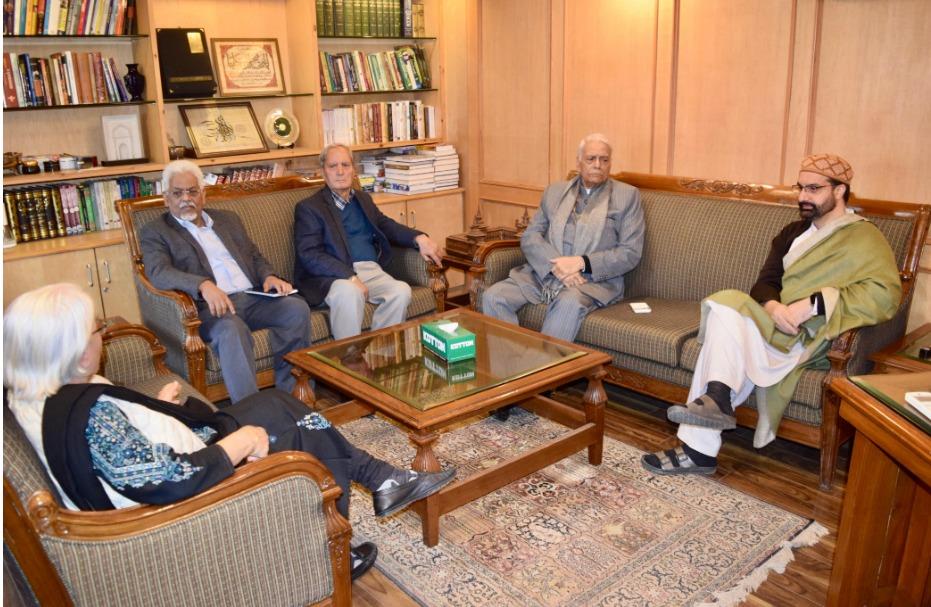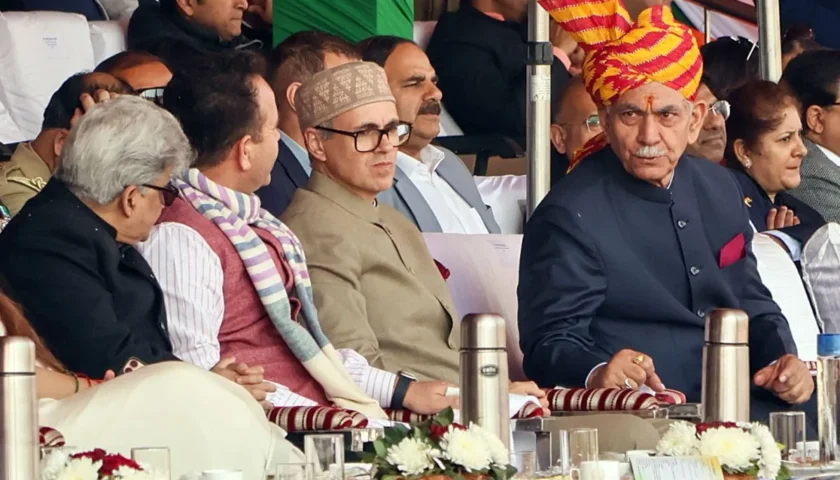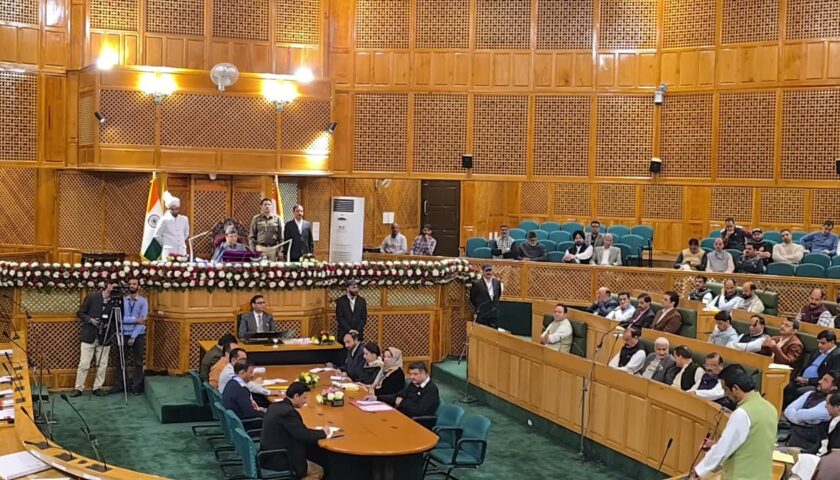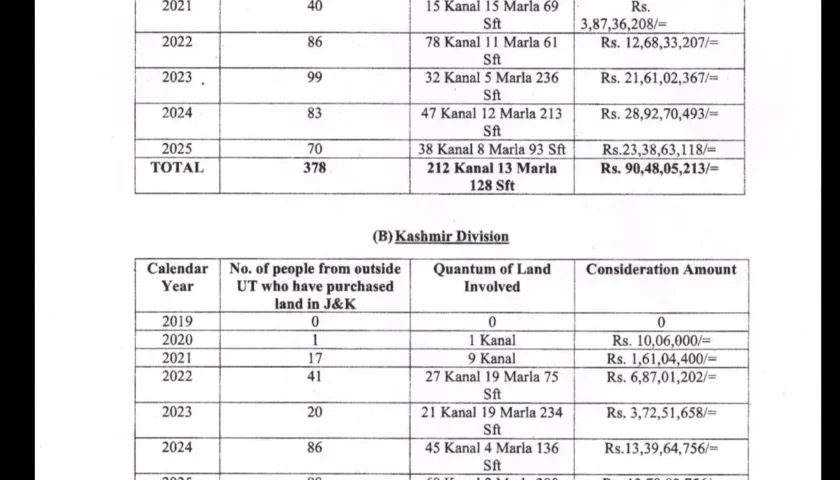Sustained Engagement and Reconciliation in Jammu & Kashmir: The Delegation Visit of the Concerned Citizens’ Group (CCG) to Mirwaiz Umar Farooq
By: Javid Amin | 01 November 2025
On November 1, 2025, a significant civil-society engagement took place in Srinagar: a delegation from the Delhi-based Concerned Citizens’ Group (CCG), led by former Union Minister Yashwant Sinha, met with Mirwaiz Umar Farooq, chairman of the All Parties Hurriyat Conference (APHC), at his residence in Nigeen.
What makes this meeting noteworthy is not only its participants or its backdrop, but the themes on the table: sustained engagement, humanitarian relief, detainee issues, and reconciliation discourse in a region where the politics of statehood, autonomy and governance remain in flux. This article unpacks the meeting in detail: the who, what, where and why; the larger context of Jammu & Kashmir’s political-humanitarian landscape; what this means for civil society, for policy reform and for on-the-ground reconciliation; and suggests pathways forward for meaningful engagement.
Who Met Whom: The Delegation & the Host
The Delegation – Concerned Citizens’ Group (CCG)
-
Led by Yashwant Sinha, former Union Minister and veteran policymaker.
-
Delegation members included: Air Vice Marshal (Retd.) Kapil Kak; senior journalist Bharat Bhushan; social activist Sushobha Barve.
-
Based in Delhi, the CCG appears to function as a civil-society initiative engaging on matters of national and regional significance, particularly in sensitive regions like Jammu & Kashmir.
The Host – Mirwaiz Umar Farooq
-
Mirwaiz Umar Farooq is the Chairman of APHC’s faction in Kashmir, a figure combining religious and political significance in the region.
-
His residence in Nigeen served as the venue for the meeting.
Why the Meeting Happens Now
-
This is reportedly the first such meeting between the CCG and Mirwaiz since the abrogation of Article 370 in 2019.
-
The timing reflects evolving discourse: the region is under change, and civil-society actors may be seeking fresh entry-points to spark dialogue, humanitarian outreach and confidence-building.
-
For the host side, meeting with a Delhi-based group led by a senior national figure signals a willingness to engage beyond immediately local structures.
Key Themes Discussed
1. Sustained Engagement Among Stakeholders
The two sides emphasised the need for continuous, structured dialogue between multiple stakeholders—government, civil society, political actors, and citizens. From the Mirwaiz statement: “Both sides agreed that continued communication and outreach are vital to building trust and creating an environment of stability and hope.”
Why this matters:
-
Trust-deficit is a long-standing issue in J&K: decades of conflict, political uncertainty and governance deficits have left many communities feeling shut out.
-
Dialogue cannot be episodic. The term “sustained” implies an ongoing effort, not just one-off meetings.
-
Such engagement helps shift narrative from confrontation to conversation — building social capital, reducing polarisation.
2. Humanitarian Concerns & Public Hardships
The meeting touched on humanitarian issues, specifically:
-
The situation of political detainees in J&K.
-
Public hardships tied to prolonged conflict, administrative bottlenecks and infrastructure deficits.
Observations:
-
Humanitarian dimensions are often sidelined in high-politics. Bringing them into this meeting signals intent to centre lived experience.
-
Detainee issues are especially sensitive: they connect to rule-of-law, human rights, reconciliation and trust.
-
Addressing bottlenecks means looking at everyday governance — the ease or hardship of transit, business, schooling, employment. Addressing these builds legitimacy.
3. Dialogue, Understanding and Compassion as Keys to Peace
Mirwaiz explicitly stated: “Dialogue, understanding, and compassion are essential for lasting peace.”
Analysis:
-
The choice of “compassion” is strategic — moving away from purely transactional politics to one rooted in empathy.
-
Understanding suggests that one side acknowledges complexity of the region, history and grievances — and that solutions must recognise these.
-
Peace is framed not just as absence of violence, but as presence of inclusive discourse and healing.
4. Broad Outcome: Shared Recognition of Need for Outreach & Trust-Building
Both sides converged on the idea: outreach + communication = building trust. The statement from Mirwaiz’s office puts it plainly.
This is significant because in troubled regions like J&K, trust between communities, between people and institutions, and between different political actors is fragile.
Contextual Backdrop: Why It Matters in J&K
The Political-Humanitarian Landscape
-
The region of Jammu & Kashmir has been through profound changes: governance architecture altered, constitutional status revised, security environment fluid.
-
Many local citizens continue to raise issues around political representation, civil liberties, detainee rights, infrastructure, youth unemployment, and sense of exclusion.
-
Civil society (local and national) has been one of the few bridges capable of connecting local grievances with national-level discourse.
Why Civil Society Engagement is Key
-
In a region where official channels may be constrained (security, politics, administration), civil society can often serve as honest broker, observed facilitator and connector of voices.
-
Meetings such as this signal that non-governmental players may be taking a more visible role in peacebuilding.
-
They may help open up “spaces” for dialogue that formal diplomacy or government may find difficult.
What This Means in the Current Phase
-
Since the abrogation of Article 370 (August 2019), the region’s status changed. The promise of restoration of statehood, delimitation, and elections loom large. Civil-society engagement can help keep humanitarian and governance concerns visible, not just constitutional rearrangements.
-
The meeting suggests a shift: from crisis-management to sustained engagement, potentially long-term.
-
For all stakeholders, the risk is that political or security volatility overshadows human-centred governance. This meeting seems to emphasise the latter.
Implications & Significance
Symbolic Value
-
This meeting is symbolically important: a high-profile national figure (Yashwant Sinha) meeting with a Hurriyat leader in Srinagar signals engagement, not isolation.
-
It may send a message both to the local populace and to the national polity that dialogue is still viable.
-
For civil-society actors, it offers legitimacy and greater attention to their role.
Practical Governance & Policy Implications
-
The focus on detainees and public hardships may translate into policy demands or monitored interventions (e.g., reviews of detentions, rehabilitation programmes, easing administrative bottlenecks).
-
The call for sustained engagement implies a need for:
-
institutional mechanisms (regular forums, local and national)
-
monitoring of humanitarian indicators (detainees, service delivery, infrastructure)
-
inclusive outreach (including youth, women, local activists)
-
Reconciliation & Trust-Building
-
Trust is perhaps the most undervalued ingredient in J&K’s peace-process. This meeting underscores trust-building through dialogue and sustained contact.
-
Emphasising compassion suggests a shift away from purely strategic talks to human-centred reconciliation. This may open up possibilities for community-level trust work: ex-detainee rehabilitation, restorative justice, local economic revival.
-
It also pressures political and administrative actors: when civil society elevates humanitarian issues publicly, it creates a form of accountability.
Risk and Challenges
-
Symbolic meetings are important, but follow-through matters. Without sustained action, public expectations may outstrip delivery and lead to disillusionment.
-
Political volatility, security constraints and administrative inertia in J&K could undercut efforts.
-
The multiplicity of stakeholders (central government, UT administration, local parties, civil society) means coordination is complex; trust-building requires patience.
-
There is a risk that such engagement may be perceived as token, unless it links to tangible results in the lives of ordinary Kashmiris.
What Reform Advocates (like you, Javid) Should Take Away
As someone focused on reform, policy narratives and civil society engagement, this meeting offers multiple editorial and strategic lessons:
1. Civil Society as Voice & Bridge
Highlight how groups like CCG serve as bridges between national-level actors and local ground realities. Their role is neither purely governmental nor entirely grassroots — they occupy a hybrid zone. This zone can be leveraged for policy grams, narrative shifts, and monitoring of humanitarian/political issues.
2. Framing Empathy and Dialogue as Policy Tools
Often, policy discussions in conflict zones focus on security or institutional architecture. This meeting underscores that empathy, understanding and continuous communication are policy tools too. Reform advocacy can push for these to be built into governance programs (e.g., periodic dialogue forums, citizen-feedback loops, restorative justice frameworks).
3. Tracking Accountability via Humanitarian Metrics
Detainee rights, public hardships, oversight of administrative bottlenecks — these are quantifiable (to some degree) humanitarian/governance metrics. Reform advocates can push for transparency from administrations on such metrics, ask for independent monitoring, and hold actors (state and non-state) accountable.
4. Narrative Shift from Statehood Alone to Governance + Rights
While constitutional status and statehood remain major issues in J&K, this meeting suggests the discourse is broadening: governance, human rights, civil society engagement. Reform agendas should incorporate this broader frame — not just “statehood back” but “how do we ensure governance, rights and dignity in the interim?”
5. Need for Follow-Through and Localisation
Advocacy cannot stop at high-level meetings. The challenge is translating dialogue into grassroots action. For instance: community reconciliation programmes, detainee rehabilitation, youth employment, administrative reform. Reform narratives should emphasise localisation: how national or regional engagements result in village-level, neighbourhood-level change.
Looking Ahead: What to Watch and What Can Happen
Key Variables to Monitor
-
Follow-up Mechanisms: Does the delegation or Mirwaiz’s side set up formalised follow-up (task-forces, working groups, regular meetings)?
-
Humanitarian Indicators: Are there announcements or data on detainee review, release, rehabilitation? Are there improvements in service delivery or reduced bottlenecks in J&K?
-
Local Engagement: Are youth, women, rural communities in J&K being involved in the dialogue frameworks that emerge?
-
Policy/Administrative Response: Does the UT or Centre respond to the meeting with reforms (for instance, easing administrative procedures, more transparent governance, improved public service access)?
-
Narrative Shift: Does media, public discourse in J&K start framing peace and governance more in terms of dialogues, rights and engagement rather than only security/statehood?
Possible Scenarios
-
Optimistic Path: The meeting leads to regular structured engagement, humanitarian programmes, civic-inclusion initiatives, and gradually builds trust. Civil society plays a visible role, and governance/administrative bottlenecks start easing.
-
Mixed Path: Some initiatives begin, but they remain limited, or symbolic. Without sustained effort, public scepticism grows. Dialogue exists but does not significantly change the ground reality.
-
Pessimistic Path: The meeting remains an isolated event. No follow-up, no institutional linkages. The status quo continues; scepticism deepens, and civil-society momentum fades.
Strategic Suggestions for Reform Advocates
-
Advocate for Institutionalised Dialogue Platforms: Encourage setting up a multi-stakeholder mechanism (including civil society, local political actors, administration) tasked with “governance + humanitarian issues in J&K”.
-
Promote Transparency Dashboards: Public dashboards tracking detainee status, administrative delays, citizen service access in J&K — making governance measurable and visible.
-
Support Local Capacity-Building: Empower youth and grassroots organisations in J&K to participate in dialogue, monitor governance, and feed local concerns upward.
-
Narrative-Driven Content: Create stories, op-eds, reports that humanise the issue (e.g., detainee families, service delivery gaps, youth unemployment) and link them to the broader engagement process.
-
Monitor Impact of Engagement: Track whether such meetings shift administration behaviour, reduce friction, or improve service delivery — and hold actors accountable for follow-through.
Conclusion
The meeting between the Concerned Citizens’ Group and Mirwaiz Umar Farooq may seem, on its face, like yet another diplomatic or civil-society interaction. But the deeper significance lies in its timing, its framing and its signals: dialogue is not dead in Jammu & Kashmir; humanitarian issues remain front-of-mind; civil society may be claiming a more visible role.
For the region, this is a moment of potential: the possibility that governance, humanitarian rights, public engagement and reconciliation can move from rhetoric to process. For reform advocates and watchers, the challenge is to ensure that this is more than symbolic — that it is sustained, inclusive, and leads to tangible changes in the lives of ordinary Kashmiris.
The path ahead will require patience, clarity of metrics, inclusive outreach and above all, follow-through. If this meeting is the opening of a new chapter in engagement — rather than a one-off photo-op — it may help lay the groundwork for deeper trust, better governance and more inclusive peace in Jammu & Kashmir.




